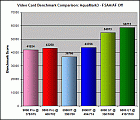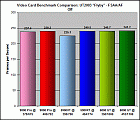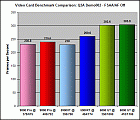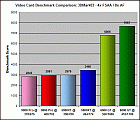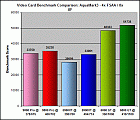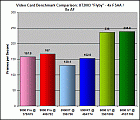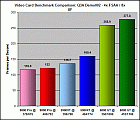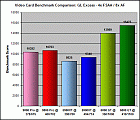| BENCHMARKING PLATFORM & TEST PLAN... |

The video benchmarking was done using my personal PC; the basic configuration details are shown in the table at right. As a basis of comparison, I utilized the same benchmarking scheme that I had used in a previous video card article that you can see HERE. Thus, the benchmarking results reported here for the 6800 GT can be compared directly to the prior results I obtained for the Radeon 9800 Pro and GeforceFX 5900XT. The testing scheme was comprised of a total of six benchmarks, consisting of both "synthetic" multi-test video benchmarks and actual games, and employing both OpenGL and Direct3D rendering modes:
- 3DMark03 Build 350 Multi-test Video Benchmark (DirectX 9)
- 3DMark2001 SE Build 330 Multi-test Video Benchmark (DirectX 8)
- AquaMark3 Multi-test Video Benchmark (DirectX 9)
- Unreal Tournament 2003 Demo v.226 Benchmark Test (DirectX 8 game)
- Quake 3 Arena "Demo002" Timedemo (OpenGL game)
- GL Excess v.1.2b Multi-test Video Benchmark (OpenGL)
For each of these tests, the benchmark was run under four different conditions:
- Default core & memory clockspeeds, anti-aliasing & anisotropic filtering off
- Default core & memory clockspeeds, 4x anti-aliasing & 8x anisotropic filtering
- Overclocked core & memory settings, anti-aliasing & anisotropic filtering off
- Overclocked core & memory settings, 4x anti-aliasing & 8x anisotropic filtering
Considering the relative ease with which today's video cards can be overclocked and the resulting free speed boost, the inclusion of overclocked data has become "standard operating procedure" in studies of this sort. Including data to quantify the impact of anti-aliasing (AA) and anisotropic filtering (AF) has also become de rigueur, since these visual quality enhancement techniques are so widely used now, and they can impose a significant frame-rate penalty, especially AA. However, as the results will show, that performance penalty is getting much smaller with the latest 3D hardware and rendering technology!
All of the testing was done at a screen resolution of 1024x768 and 32-bit color depth, with the exception of the Quake 3 Arena timedemo, which was run at 1600x1200x32. This higher resolution setting was used because this older game just doesn't "push" a video card hard enough at 1024x768. In fact, you will notice in the following data and charts that several of these tests show very little differentiation between the three video cards, particularly with AA and AF turned off. That does not imply that there isn't much difference between the cards, but rather that all three have enough 3D processing horsepower that other portions of the test system, notably the CPU, AGP bus or system memory bandwidth, can become the limiting factors. Thus, the biggest difference between the cards will be shown on the most demanding 3D benchmarks, like 3DMark03 or GL Excess, especially when the AA and AF settings are cranked up. Clearly, my future video card reviews are going to require dropping some of the older tests and adding some tougher new ones!
Overclocking of the 6800 GT was accomplished by installing the "Coolbits 2.0" registry hack for the Nvidia drivers, available for download HERE. Upper limits were determined empirically for my particular card by gradually dialing up the core and memory clockspeeds (one at a time!) until visual anomalies or freeze-ups occurred during benchmark looping, then backing off by a few MHz. Using this approach, I was able to go from the stock core/memory settings of 350/1000 up to 410/1100. While this may represent a fairly modest increase (17% core, 10% memory) by a hardcore overclocker's standards, consider that the much more expensive 6800 Ultra uses default clock settings of 400/1100. Thus, I was able to achieve clockspeeds slightly better than a card that typically costs $175 more than what I paid for my Albatron 6800 GT. Now, that's the kind of value you've gotta love, if you're a 3D enthusiast!
So, let's move on to the benchmark results and their interpretation....
| BENCHMARKING RESULTS |
The test data for the three different video cards is summarized in the following table and graphs:
Benchmark Result Summary Table

Benchmark Result Charts
(Click on charts to see full size version)
| ANALYSIS & CONCLUSIONS |
While the performance levels achieved by the 6800 GT come as no real surprise, the magnitude of its domination--particularly when AA and AF are turned on--is quite impressive. Let's take a look at the performance of the card in more detail:
Overall Rendering Speed - No surprises here, as the 6800 GT gives the highest scores on every test. Indeed, the only surprise would have been if it didn't. As mentioned previously, the magnitude of its advantage is quite small in a couple of the tests where AA and AF are turned off, notably Unreal Tournament 2003's "Flyby" benchmark, and 3DMark2001SE. But these older tests are simply no match for these newer video cards, and the difference between them only begins to be evident with AA and AF turned on. The superiority of the 6800 GT is most obvious in 3DMark03, the most demanding of the tests used here. It basically doubles the speed of the 9800 Pro and 5900 XT cards with AA and AF off, and increases this advantage to about 150% at 4xAA/8xAF settings. Since the latest games, such as Doom3 and Half-Life 2, would be expected to be similarly taxing on a video card, it looks like the gamer who upgrades to the 6800 GT to handle these newer titles shouldn't be disappointed in the performance boost obtained.
Anti-aliasing/Anisotropic Filtering Performance Penalty - This is where the 6800 GT really shines. I mean, this bad boy barely blinks when running 4xAA/8xAF settings. Even on the most stringent 3D tests employed here, the frame-rate penalty only gets into the mid-30% range, and is often well under 15%! Compared to the 40 - 50% penalties commonly incurred on the two older cards, this is very impressive performance. Unless you're trying to run something super-demanding like Doom3 at high quality and resolution settings, there's no reason not to turn up the AA and AF and enjoy the improved visual quality they bring.
Overclocking Extent & Impact - Though not a huge overclocker on a percentage basis, the 17% core and 10% memory speed increases achieved for the 6800 GT are certainly respectable. Given that they put the card slightly ahead of the stock clockspeeds of the much more costly 6800 Ultra, the buyer (me, in this case!) has to be pretty pleased with this result. As far as overclocking efficiency goes--the rendering speed increase per incremental clock cycle--this is most clearly evident in 3DMark03, where the test can truly reflect the impact of the higher clockspeeds. Dividing the percentage increase in the benchmark result by the mean clockspeed increase of the core and memory, an overclocking efficiency in excess of 90% is calculated for 3DMark03. Nice!
Image Quality - Here's the one area where I still have to give the advantage to my old Radeon 9800 Pro. Though Nvidia has closed the gap, I still slightly prefer the visual quality of the ATI cards. The overall image looks a bit smoother to me, and colors appear somewhat richer and more vibrant. Also, I prefer the appearance produced by ATI's anti-aliasing algorithm to Nvidia's. Diagonal lines and surfaces appear a bit straighter and smoother on the 9800 Pro than what I see with the 6800 GT. The difference is subtle, but noticeable when I look closely.
| THE BOTTOM LINE |
Without a doubt, the 6800 GT is an impressive piece of technology, and a very significant win for Nvidia. After clearly trailing ATI in the last couple of product cycles, Nvidia appears to have regained parity, at the very least, based upon the heads-up testing against the corresponding Radeon X800 series cards that I've read about. Certainly, my own testing shows the 6800 GT to be an exceedingly capable video card, head and shoulders above the last offerings from both ATI and Nvidia. This card should hold its own against any of the newest games, when run at anything but the most extreme quality and resolution settings.
The final question to be answered is, "Is it worth almost $400??" Ultimately, that has to be a personal call. In my case, I have to say, "Yes". The performance boost I've seen is very impressive, and the ability to reach 6800 Ultra speeds with a bit of overclocking is a nice bonus that adds to the perceived value of the card. Plus, I expect to recoup a bit of my purchase price by selling my 9800 Pro (offers, anyone?). Sure, $374 is a lot of money. But, wow! This is a LOT OF CARD!!
|
November 24, 2004
Questions or comments? E-mail me at THIS LINK |
|


